
24 minute read
Rammstein

For a band that is larger than life in every sense, it’s surprising that Rammstein has never entered the world of stadium touring. An everpresent name on the live bucket lists of most metal and rock fans, the German powerhouse has raised the bar year after year, with some of the most extreme shows imaginable. So, when TPi got the invitation to come along and witness the final night of the band’s European Stadium Tour, I couldn’t book my flights fast enough. This latest outing coincided with the band’s new album – its first release in 10 years. The mysterious untitled LP came out with very little fanfare or promotion, but as soon as it dropped, it was embraced by their fans – many of whom flocked to stadiums across Europe to see exactly what a Rammstein stadium show entailed. As TPi entered Vienna’s Ernst Happel Stadium, after squeezing through the sea of black shirts – most of which were emblazed proudly with the band’s cross logo – we set about meeting the fine men and women who had kept the band’s ambitions production on the road.
PRODUCTION ORIGINS Our first stop was with none other than Production Manager Nicolai Sabottka. Having been with the band since the late ’90s, the PM knows in intimate detail the level of planning and technical organisation that goes into managing the madness of a Rammstein show. But despite decades at the wheel, Sabottka stated this tour presented a whole new level for the sixpiece. “The sheer size and logistics for this tour were very different to what we have done in previous years,” he commented. “The goal was to make a big statement – one that said, ‘here we are, stadium size with our new album and the largest show we’ve ever done’. And now that we don’t have a roof, the sky really is the limit.” Th e PM brought in some fresh faces to the established core crew for the 2019 run. This included suppliers Neg Earth, Solotech, SSE Audio Group, Stageco, WIcreations, QNetic and The Power Shop, along with return
suppliers Trucking Services and Brilliant Stages. Not forgetting pyrotechnic specialist, ffp – a company which Sabottka is also the Managing Director – but more on that later. Along with a selection of new suppliers, Sabottka and the wider management team also brought in new creative heads in the form of Woodroffe Bassett Design’s Show Designer Patrick Woodroffe, Lighting Designer Roland Greil, who led the project for WBD, Set Designer Florian Wieder of Wieder Design Studios and Set Designer Cuno Hahn. All of whom worked closely with the band who played a major role in the development of the stage design. Having both started their careers in the Munich region, Greil and Wieder already knew one another and had even collaborated on a recent project in China. Having grown up in Germany, surely working with Rammstein was something of a dream job? “They are certainly one of those artists you want to tick off the list,” admitted Greil. “Rammstein is very tempting for any creative or designer. It really is a playground. The term ‘over the top’ doesn’t really exist here and their live performance is unlike anything else.” Th e project presented something of a departure for Wieder, who usually works in the realms of major TV events such as the Eurovision Song Contest. “Rock ’n’ roll touring has not really been Florian’s territory,” stated Greil, discussing the collaboration with the production designer. “The fact he is not from this world meant he brought some very different options to the table.”
SETTING THE STAGE Before getting into the specifics of the various departments, it’s worth noting the monolithic set that acted as a backdrop for the tour, which took the form of a dystopian tower block all built around a central 36m-high tower – think Lord of The Rings meets 1984 and you’re part of the way there. The stage build was a collaboration between three companies; Stageco, Brilliant Stages and WIcreations. With so many parts to the stage, Sabottka
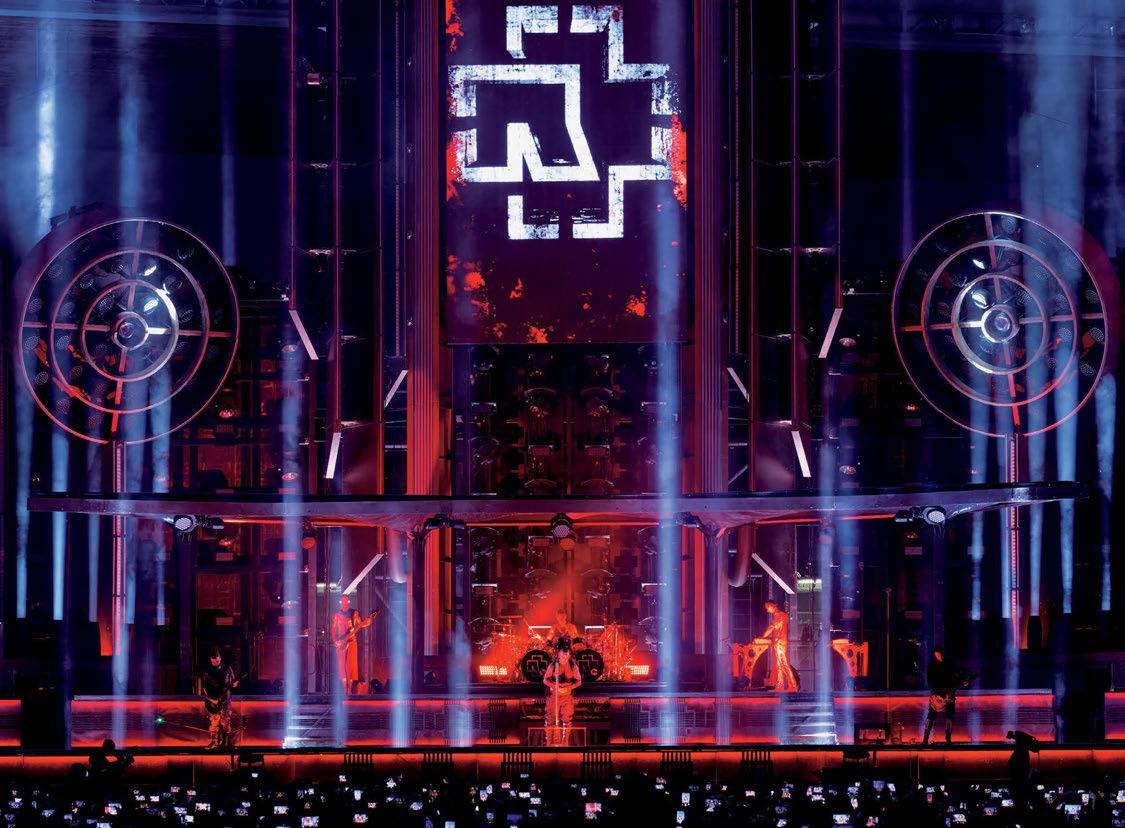
called on the services of Jeremy Lloyd of Wonder Works, who oversaw the technical engineering to ensure the outlandish design was crafted into a reliable touring package. “One of the major challenges in the initial stages of the tour came when the band pulled the plug on some of the original designs,” reminisced Sabottka. “We had several weeks of redesigning and readjusting to ensure it was up and running for when the tour was scheduled to go out. Jeremy from Wonder Works was integral in these changes coordinating all the technical aspects. I don’t know how we would have done it without him.” Discussing the steel backbone of the show was Stageco’s Project Director, Dirk De Decker. “It was always going to be a super-impressive production on a scale that Rammstein had never presented before – and that’s saying something,” he commented. “This was the first time they were going to tour with a dedicated stage at every venue.” Despite venturing into uncharted waters, the Project Director explained that due to the “infrastructure behind Rammstein’s organisation” a solid flow of communication was created. “It all worked like a dream,” he reported. The skeleton of the high tower was made of Stageco’s black steel, which happened to fit in with the rest of the build’s aesthetic. “Although the steel isn’t meant to be a feature of the design, it is incorporated in a way that is complementary,” commented De Decker on the happy coincidence. Stageco also provided two, 23m-high downstage PA towers along with two custom-designed transparent band roofs – each supported on four columns that housed cabling for pyro effects. Finally, the staging specialist provided four delay towers, FOH control risers and all the stage decking. “I c an’t think of a single element that has not been custom designed for this tour,” concluded De Decker. “This combination had to work at very high speed to reach deadlines, and the experience of this extraordinary team of vendors really paid off.” It’s was this speed that Sabottka commented was one of the biggest logistical hurdles with the tour. “As is commonplace with a tour of this size, you end up leap-frogging your steel system,” he explained. “Ensuring the
steel got to each venue ahead of the production was Peter Smiet, who provided 20 trucks, with an additional 45 of the Trucking Services fleet following suit with the rest of the production.” Overseeing the rest of the set elements for the tour was Head Carpenter Aaron Alfaro. He had worked with Jeremy Lloyd numerous times over the years although, as he explained, never as closely as he had on this project. “In the early stages I went on vendor visits with Jeremy when we were pulling the pieces of this one together,” commented Alfaro. “It’s always the case that what works on CAD is often quite tight when you begin to put together a set. However, we’ve got ourselves to a good place now with this version of the stage set.” The performance stage was created by Brilliant Stages, which provided a rolling house stage, tech bunkers, band riser and drum risers. The company used 150m of black PUFC fabric to ensure the whole system was waterproofed, as the whole production was touring without a roof. The whole main stage was covered in Yorgrip – a specialist high-grip aluminium surface finish that was tough and flameproof, allowing Rammstein to perform their usual pyro-heavy energetic show. The company also created a multi-axis stage lift capable of lifting 500kg that could double-up as a ramp or a straight lift in a single unit. This was built on a separate rolling dolly for ease of transportation and included a separate power pack. “This was an enjoyable project to manage with a band that Brilliant Stages has supported for a number of years,” reflected Alan Carradus, Brilliant Stages Project Manager. “Rammstein always pushes the envelope in terms of effects, whilst keeping the ‘feel’ that their fans love. Onwards to the next tour in 2020.” The final engineering arm of this gargantuan stage was Belgium’s WIcreations, which provided several custom staging and automation elements – all of which were coordinated by the company’s Koen Peeters and Hans Willems. Due to the magnitude of the project, the company opted to integrate its new WImotion system, which gave precise control and
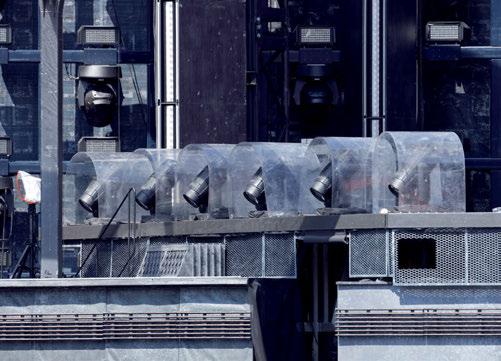
synchronisation of individual and group moving chain hoists, utilising SIL3 group position monitoring. The centrepiece of the tower was a 5m by 9m LED video screen that had the ability to track up and down the structure. With the screen being very much open to the elements, it had to be wind-braced and guided along a set of vertical rails to allow an in-use wind loading of 15m per second. Th is was not the only piece of automation that was seen on the tower, with WIcreations also providing a scenic lift platform that raised all six members of the band 26m above the stage during the explosive firework finale. A total of 10 1,250kg SIL3 WImotion hoists were used to move the video screen and band platform. The WI-hoists were controlled by WI-VSD
SIL3+ controllers. These multipurpose WImotion controllers guaranteed a SIL3 safety level. At the heart of this machinery system was the WImotion controller, which dealt with the individual and group synchronisation of all the moving chain hoists. Using the all-new WI-Desk with touchscreen-enabled user interface and running WI’s proprietary MCA control software, the operator could ‘joystick’ the hoists into position. MCA also allowed for the easy setup of group halt options, enabling a ‘position lock’ for all motors in a group and to set the maximum group and individual channel loads. Lastly, on the physical set was ShowTex, which oversaw the impressive Kabuki drop that took place early on in the show, with red banners with the band logo descending from the top of the set. In total, six 3m-wide and four 1.5m-wide banners were deployed – all of which dropped to a length of 9m. “We used polyestergauze as a bag because it would not hold any water in case of bad weather,” explained ShowTex’s Bo Bettens. “The fabric used is Cyclo 300 CS Print because of the weight and it’s IFR (Inherently Flame Retardant) quality.” More than necessary when you’re talking about a Rammstein show.
LIGHTING Turning the conversation back to Greil, the LD talked about the lighting rig deployed. “One of the first things that was of vital importance was that the rig had a lot of firepower,” asserted Greil, as he began to list the various fixtures on his rig. “It was also important to choose fixtures that didn’t look too ‘pop’ and were able to fit into the industrial-steampunk aesthetic.” Gr eil was keen to emphasise the benefit of WBD’s team working closely with Set Designer, Florian Wieder. “As we designed the stage together, we were able to integrate good lighting positions that worked with the set rather than having to find positions awkwardly in a pre-designed set. Therefore, we designed various lighting elements to be integrated into the set design, which could be used on their own to create incredible scenes or

combined with other elements for the later parts of the show, making even bigger and more impactful looks.” The band also played its part in influencing which fixtures were selected for the tour. “They’ve always enjoyed the look of big search lights,” revealed Greil. “With this in mind, we selected the AO Lighting FALCON xenon searchlights that were placed in several locations across the stage.” Along with these powerful search lights, Greil also opted for Vari-Lite VL6000s to give some variety to the “beam-looks” the band wanted. In line with the spotlight theme, Wieder designed the four gigantic ‘searchlight structures’ measuring 3.5m in diameter and filled with Claypaky K25s. “I’ve been really impressed with the K25s,” he stated. “They are really bright and fulfilled the technical needs for the look. We used 32 of the fixtures for each circular light fitting – I used 128 in total.” The downstage towers also served a different purpose, housing verticals on the inside which held Greil’s main workhorse fixture for lighting the band – the Claypaky Scenius Unicos – in tandem with the Follow-Me system. Collectively, six Follow-Me controllers were arranged backstage to track all six musicians. “Key lighting comes mainly from the side light, although we combine some with automated Robe BMFL LT FOH spots, which are controlled by the Follow-Me system as well, to create varied looks,” stated Greil. “What was also interesting with our Follow-Me set up was that we could calibrate 44 of the 56 Robe BMFL fixtures to the system, so it was possible to take all those lights and have them follow a particular member of the band. The fact that the system can control more than just a few spots fixtures is the real beauty and benefit of Follow-Me.” Upstage 14 Ayrton WildSun S25s were the main fixture to light the 38m tower, acting more as architectural lighting than a traditional show fixture. “The rig was designed to have a lot of LED fixtures for architectural lighting,” continued Greil. “As well as the WildSuns, we also opted for SGM P-10s – 69 in total – which help to show of how large the staging structure was.” Another key element in the designer’s arsenal were three Hungaro T-Light
Strobes. “It was always necessary to have a few big-ass strobes,” chuckled Greil, while commenting on the power of the Hungaros. “No LED fixture on the market can match its firepower.” Al though the industrial-steampunk look was one of the predominant themes within Greil’s design, the LD also explained that there was another look the band were keen to explore. Around the halfway point of the show, the band departed from its back catalogue, with guitarist Richard Kruspe treating the audience to a DJ intermission while the rest of the group donned LED black outfits for a Tron-inspirited dance routine. You can’t say these guys are not entertaining. To t ransform the imposing architecture of the stage, the set had been covered with LED tape – which was supplied by Brilliant Stages – creating a neat outline for the section of the show. “To push this idea even more, we wanted to add another layer of lighting,” stated Greil. “We ended up going for the Chroma-Q Color Force IIs, which we integrated into the claddings of the set.” Neg Earth Lights supplied the tour with 86 Color Force II 72s and 18 Color Force II 48s LED battens, as well as 28 Color One 100/100X LED PARs. “As the show gets bigger and more energetic through the set, the Color Force IIs deliver strong, powerful looks on their own during some songs, as well as forming part of big overall stage looks,” commented Greil. Other noteworthy fixtures on the lighting rider were 44 GLP impression X4 Bar 20s, eight X4 Bar 10s and six X4Ls, along with a mammoth 262 TMB Solaris Flare Q+s. With the design created, Greil passed on the show to FOH double act, Lighting Director Faren Matern and Lighting Programmer and Operator, Marc Brunkhardt. While Brunkhardt was relatively new to the Rammstein camp, Matern was one of the longest serving crew for the German band, having worked with them since day one. “He was a valued asset while bringing this show together,” enthused Greil, commenting that there are few people in the world who know this band better. Greil also points out, that it has been an absolute pleasure
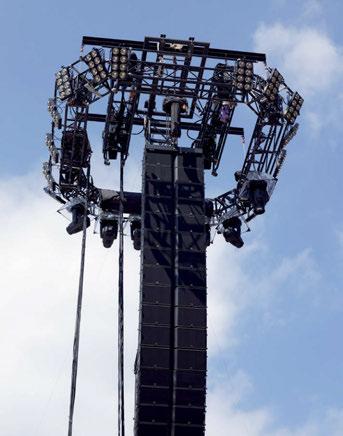
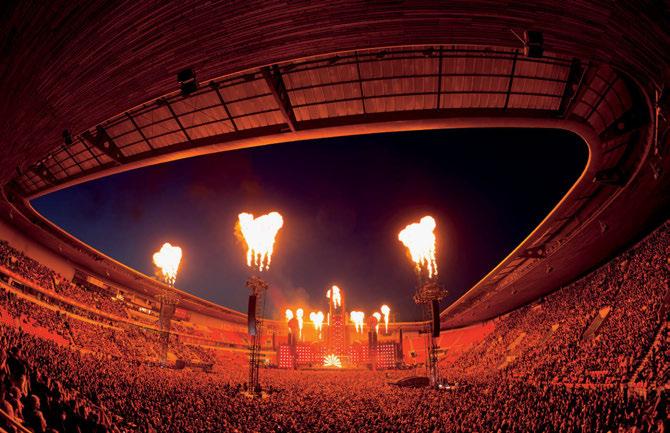

to collaborate with the band and their management. “They have been involved into the whole process from day one, which formed the perfect breeding ground to create something special,” he commented. Throughout the tour, the two operators split duties, with Brunkhardt overseeing the show cues and Matern controlling key lighting along with audience lights. “T ogether with Marc, we made the decision to specify a proven workhorse in the form of an MA Lighting grandMA2 system due to its reliability, performance and all our previous positive experiences with this console,” commented Greil. At FOH there were four grandMA2 full-size consoles (two main and two backup) with an additional grandMA2 light for stage tech. In total there were 15 MA NPUs and seven MA 8Port Nodes. When TPi first stepped into FOH to meet Brunkhardt, it was hard not to notice his unique set-up, which not only incorporated a grandMA2 but also a selection of piano peddles at his feet and a bass vibration plate. “The pedals were a later addition when we got this show on the road,” commented Brunkhardt. “We have a selection of songs where we utilise timecode, but during the run the band opted to remove it and the click. This gave me a problem as I really needed an additional ‘go’ button to keep the cues coming, so I’ve now got these three pedals. One is the master go for the main cue list, the second is to go to the next page, then the final one is to control the fog.” Although this was the first time he had created a control system like this, the LD commented he would be interested in deploying it again. Four limbs are better than two, I guess. As f or the bass plate, it all comes down to feel. “I was on a tour a while ago when there was a spare plate kicking about, which I borrowed. It just gives you a better feel so you can lock in with the band,” he explained. This also went for his decisions to use IEMs during the show. Br unkhardt walked through the progression of the show throughout the night. “Like you might expect, we are always trying to build the show up to the end,” he said. “For example, we don’t bring the Falcons in properly until
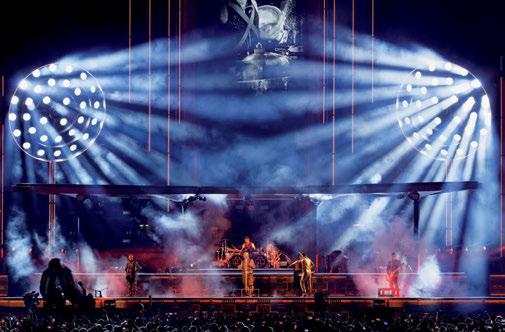
the last third of the show for the song Sonne. That’s also the song where the flames really get used to their full capacity – it gets hot, I can tell you!” Lighting vendor, Neg Earth Lights, supplied 24 Luminex GigaCore switches, nearly 70 Luminex ethernet nodes and more than 60 Luminex DMX splitters to meet the huge data requirements of the lighting system. Neg Earth’s Sam Ridgway commented: “On a network of this size, with this number of universes and parameters, we would only have felt confident using Luminex GigaCore switches.” The lighting network used a fibre backbone to link a series of GigaCore 16XT switch racks, with smaller localised satellite racks connected over standard ethernet cable. Ridgway added: “Over the last few years we have taken the decision to only stock Luminex switches, as in our opinion they offer the greatest stability and flexibility. They’re also really robust.” He continued: “Being able to interrogate the whole network system from a single location makes seeing what’s going on and any fault-finding extremely easy.” Brunkhardt was full of complements for the tour’s lighting supplier: “We’ve got many of the usual suspects from Neg Earth’s rock ’n’ roll contingent,” he said, complementing both the calibre and work ethic of the lighting crew on the tour. “I’m blessed to have Dave Ridgeway with us on this one as Project Manager. He and his team have done a great job – their years of knowledge putting on shows of this scale has been incredibly useful. There are not too many companies out there that can produce this level of show.” Brunkhardt was also quick to complement Nick Barton, Lighting Crew Chief, who he dubbed “one of the best for this style of show”.

size of these shows, there was no way to completely omit video for the design. The decision was made to only have one automated portrait screen attached to the central tower. “The screen is very much integrated into the set, which made things a little more interesting as well as giving us more room to play with,” Greil stated. “Essentially, we did all we could to make every bit of content fit in with the rest of the show. This approach to video was something that very much came from the top; with the band taking special interest in the video elements of the show, it was that much more impactful when it was used. The screen itself came courtesy of Solotech, offering its own proprietary product: a Saco 9mm. To aid with integrating the screen, all the blackout plates were taken off the back, creating a semi-transparent surface. Streaming the content to the screen were disguise gx 2s running the selection of Notch effects, which were programmed by Tim Hornung. “Our main goal was to match the colour world of each song with the live camera feeds perfectly,” commented Hornung. “Notch’s Colour Correction and Colour Grading nodes were essential in creating a consistent look between the lighting design and the video. We also used distortion and noise nodes to achieve a rough-looking effect to fit with the overall stage design of the concert. Using the disguise gx 2, I could mask around the IMAG to affect every image in real-time.” The camera package consisted of two long lens cameras at FOH along with one in the pit – “the bravest position in the show,” chuckled Greil, in reference to sheer amount of pyrotechnics taking place. On the stage there were also a selection of robo cameras to get a few select close-up shots, including images of Christian ‘Flake’ Lorenz and bass player, Oliver Riedel. Additionally, set up behind drummer Christoph Schneider was a Waterbird camera system. The rig consisted of a Waterbird Multi Slider XL System 3m with XL Control Unit and HMI Controller with foot pedals. Camera Director for the tour was Sven Offen with live visuals being created by Haeger De and David Gesellbauer. To close out the video
conversation, Greil was keen to complement the work of the tour’s video supplier, Solotech. “They are a really great company. We [Woodroffe Bassett Design] have worked with them before – most notably with our work with the Rolling Stones. I really like their kit, especially their custom touring frames that work really well and handle the demands of life on the road.”
PYRO Taking up the conversation of special effects, TPi turned back to PM, Nicolai Sabottka. For a number of years, Sabottka has juggled the responsibility of the production office while also being the Managing Director of special effects company ffp. In fact, the origin of the company was very much born from within the Rammstein touring party. “It feels natural to hold both positions,” began the PM, musing his dual role. “I do not think we would have been as efficient as we are without this shortcut. I started as their PM, but since pyro is such an important part of their show, it almost automatically had me move into that world to the point where it has now become my other day job.” Sa bottka also commented that the variety of his job role actually led to a safer stage show. “The production role is all about routine, whereas in pyrotechnics, routine is something you want to avoid at all costs, as it can give you a false sense of security.” Despite the band playing numerous open-air venues, Rammstein’s first venture into stadiums, and working with a roofless design, meant the doors were open to attempt some even more dramatic effects. “The roofless set presented somewhat of a challenge,” admitted the PM. “I had nightmares that everything would not be proportional with the effects we had originally planned.” To put his mind at ease, Sabottka and the ffp team decided to begin manufacturing larger systems. “It wasn’t until our first rehearsal day in Gelsenkirchen that I knew we succeeded,” he commented. An d larger systems meant more legwork getting all elements signed off by local authorities. “I remember early on in the tour I had climbed up on
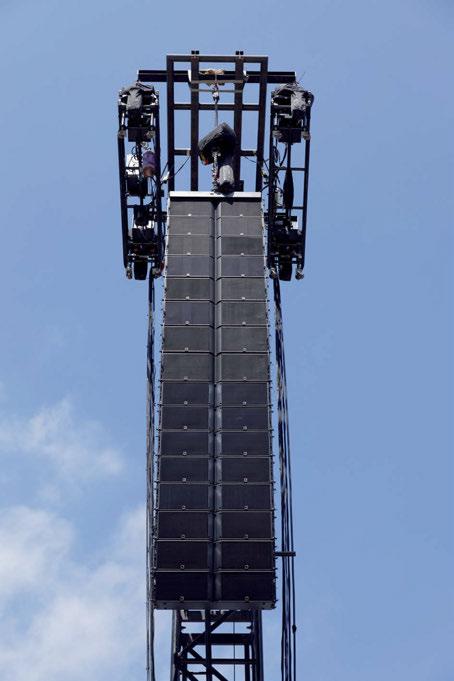

the catwalk, just above one of the delay towers, which had four large flames on, to prove to the authorities that it would not cause any damage to the roof. I came down in good health and even better spirits.” Aiding Sabottka in the pyro-endeavours was Marcin Okupnik, who has been Crew Chief for the band for a number of years. Also working in the department was Daniel Hoffmann, who leads the company’s R&D team and had the responsibility of producing many of the effects seen throughout the show. Finally, there was Alexander Hammel, who co-designed and programmed the show and shoots every night. Sa bottka was keen to praise the entire crew. “As great as all of them are, it would all be worthless without the rest of our team: Martin Hoop, Christoph Buschor, Christoph von Fintel, Franziska Robitsch, Annie-Claude Pietrera, Terrence Lumadue, Robert Ligiewitz, Sebastian Huss and Bryan Novelo,” he commented. Controlling each one of the shows was a Galaxis Advance system with an MA Lighting dot2. “It’s an incredibly well-rehearsed show,” assured Sabottka. “We don’t leave anything to chance. When we have a body effects that the shooter operates live on stage, we leave it to him or her to fine-tune the equipment, as when it comes to flaming backpacks and guitars, there is a need to give final assessment due to weather conditions and performers behaviour that day.”
AUD IO There are many reasons why some bands might be apprehensive to jump from arenas to stadiums – one of which can be the fear that the audio mix you have honed over the decades may not be replicated on the large stage. TPi met up with Audio Crew Boss, Nick Pain, to discuss the impressive array of backboxes hung among the imposing set. “T his show was very interesting from the get-go, as the band raised concerns about the sound not translating well in stadiums,” began Pain. “This meant that they and management wanted to include the audio team from the very beginning of the design period so that we were able to have enough hangs and space to provide the equipment to do the job properly. That isn’t always the case with this scale of show, which can often result

in some sort of compromise.” The rig that was hung was certainly sizable but, more importantly, it was exactly what was needed for long-time FOH Engineer, Olsen Involtini to recreate the sound that he and the band had honed over a number of years. “Olsen mixes with a very full range, which is very demanding on a PA,” explained Pain. “The one thing we discussed early on was ensuring that we had a speaker count that was able to replicate this range rather than a system that we would run ragged every night. The speaker count gave us enough headroom so as not to put the system under stress.” Th e system consisted of two main hangs of 18 L-Acoustics K1s and four K2s, with a side hang configuration of 20 K1s and four K2s. Twenty K1 subs were flown alongside the main PA hangs with a further 68 KS28s on the floor. In fill consisted of 16 Karas with 16 ARC IIs for front fills. The delay configuration varied depending on venue, but at times went up to four arrays of 18 K1s and two K2s. The entire system was powered with LA12Xs, with four Triple 27u racks for main PA and subs, four double 27u racks for the ground delays and eight single 18u racks for ring delay. “I k now these guys have been using L-Acoustics for some time,” stated Pain. “It was a natural progression for them to stay with the brand moving into this bigger space.” Suppling this mammoth rig was SSE Audio Group. The tour represented quite a milestone for the UK audio specialist, as this was the biggest stadium project it had ever handled. SSE Audio’s Operations Manager, Stefan Phillips, talked TPi through some of the technical challenges. “Pretty much everything that went out on this tour was new, designed, developed and built in house,” he began. “From winning the job to loading out, we’ve added 96 K1s, 140 K2s, 56 KS28s and 156 LA12Xs to our inventory. What everyone manged to do in such a short timeframe was impressive and a real testament to all SSE staff involved.” It’s also worth noting that while all this was going on, the team at SSE was designing a fully working L-ISA system for Mark Knopfler’s world tour – and Hugh Jackman had just started his world tour, too, creating a rather busy couple of weeks for the in-house team. No t only was this a busy time for SSE in terms of workload, but it also presented a sea change in terms of audio packages provided – particularly

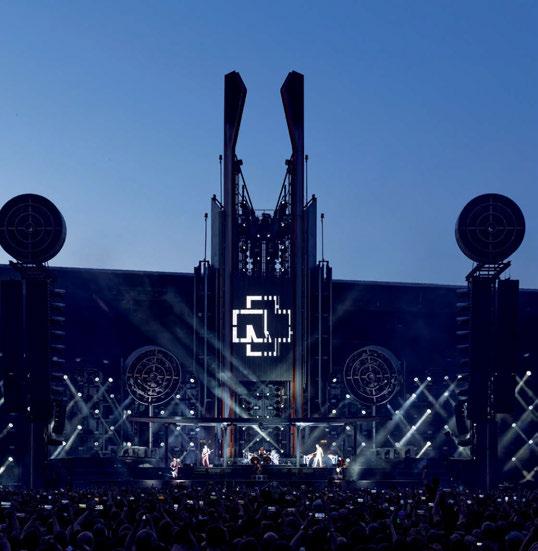
with the incorporation of AVB. “This, at the time, was one of the biggest AVB networks ever put out on the road,” explained Phillips. It was a collaboration that saw SSE work closely with both Luminex and L-Acoustics to ensure the system worked correctly. Lu minex GigaCore switches provided the network backbone for the extensive system, with 17 GigaCore 26i switches used to create a compliant infrastructure to support the huge audio system. As sistant Technical Manager, Keith Sujeeun, from SSE’s Hire division, commented: “The Luminex GigaCore switches gave us the ability to offer an AVB-compliant infrastructure, and really proved themselves in an L-Acoustics system on an earlier tour.” SS E’s standard concert tour systems usually consist of three network switches – one at FOH, one stage left and one stage right – so the Rammstein tour was both exceptional and ambitious in scale. “Rammstein’s Luminex system was capable of delivering AVB around an entire stadium, whilst being modular, to create a bigger network or break down into smaller systems,” Sujeeun added. He c oncluded: “Our technical team was impressed with how incredibly easy the switches are to use and configure. This is handy for people who aren’t very familiar with IT. They are also solidly made, which really matters when they’re being transported from country to country during a tour.” Pain also commented on the new distribution system. “It’s been an interesting change and we had help from both L-Acoustics and Luminex to get the system up and running,” he said. “Right now, it’s rock solid.” For FOH control, SSE provided two Avid S6Ls – a main and a backup. Both desks ran independent Waves engines. “Technically, we could have midi-linked both desks,” stated Pain. However, Involtini was keen to keep both desks segregated, with his FOH Tech mirroring any changes he made during the show as well as handling any issue that might need to be addressed throughout the performance.
MONITORS Moving the conversation onto onstage sound, TPi caught up with Monitor Engineer, Alex Becker, in his stage left bunker. From behind his Avid S6L, he discussed some of the highlights of the monitor package. Th e band opted for a dual offering of both onstage wedges and side fills, along with an IEM package. “Only Oliver [bassist] and Flake [keyboarder] were on IEMS for a long time, with the rest of the band opting for wedges, but slowly the rest of the guys have also moved onto in-ear – apart from our singer, Till. As Till is the only one who needs on-stage sound, it means I can just flood the stage with sound.” Becker had quite the extensive floor monitor package, which was housed under the grilled stage floor. In total there were 26 X15s under the stage. The engineer also had a left and right hang configuration of six K2s flown per side. “It’s the first time I’ve used the K2s as side fills,” stated Becker, acknowledging that using a box for this purpose was slightly out of the norm. “I’m really just using the low frequency from the top two cabinets and muting the highs and mids, which gives the ‘feel’ on stage for the guys.”
The under-stage wedges posed an interesting challenge for the audio team. “The stage is open to the elements,” commented Pain, who discussed the day-to-day maintenance of the wedge setup. “The X15s are pointing almost upwards, which means the horns are essentially acting as buckets to anything that lands on them. Thankfully, we’ve had decent weather through most of this run. But Till is known to throw water on the stage, which we had to consider. We also had some pyro effects that used Lycopodium. When it burns it turns into a really fine powder that settles everywhere and is able to go through the mesh of the wedges.” The solution to these issues was a well-organised maintenance system and regular cleaning of the boxes. Fo r IEMs, the audio department opted for Shure PSM1000s, matching the main wireless microphone with an AD4D wireless system with an 83 capsule. Those who know Rammstein will be more than familiar with Till’s unique microphones, which are often encased in either a steel pipe or other more provocative objects – I’ll let you Google that one. “This did create an interesting problem,” laughed Becker, who showed how the signal was lost as soon as the capsule was encased in the metal pipe. “The solution we came up with was to essentially cut a discreet hole in the pipe to allow wireless transmission.” Becker continued to discuss his day-to-day procedure. “I look after the whole band bar Richard [lead guitarist], who has his own dedicated Monitor Engineer – also using an Avid S6L.” Becker continued to discuss the benefits of the S6L setup. “In the past I’ve used other brands for Rammstein, but we decided to start from scratch and thought it would be better to keep the brands consistent between FOH and monitors. We’ve got all the desks in one loop and its sounds great.” As the band climbed aboard the stage lift which raised the six musicians high above their adoring fans in Vienna, Rammstein’s 2019 stadium run drew to a close. Both within the industry and outside it, it had certainly been one of the more talked-about productions of the year. But for those of you wishing you had caught this stadium spectacular, fear not, as the band and their loyal crew are due to head out once again in May 2020. TPi Photo: Manfred H. Vogel www.rammstein.de www.woodroffebassett.com www.negearth.com www.solotech.com www.sseaudiogroup.com www.stageco.com www.wicreations.com www.brilliantstages.com www.thepowershop.eu www.ffp-fx.net www.wonder.co.uk www.showtex.com www.truckingservice.de


